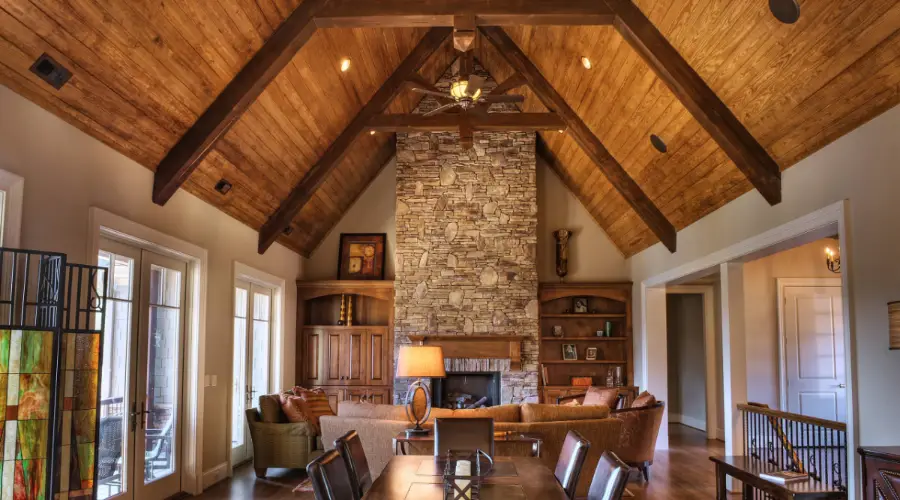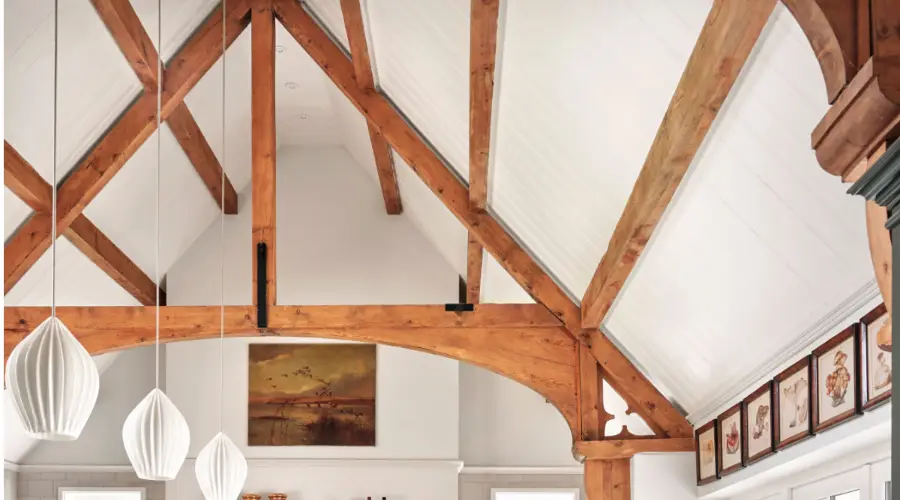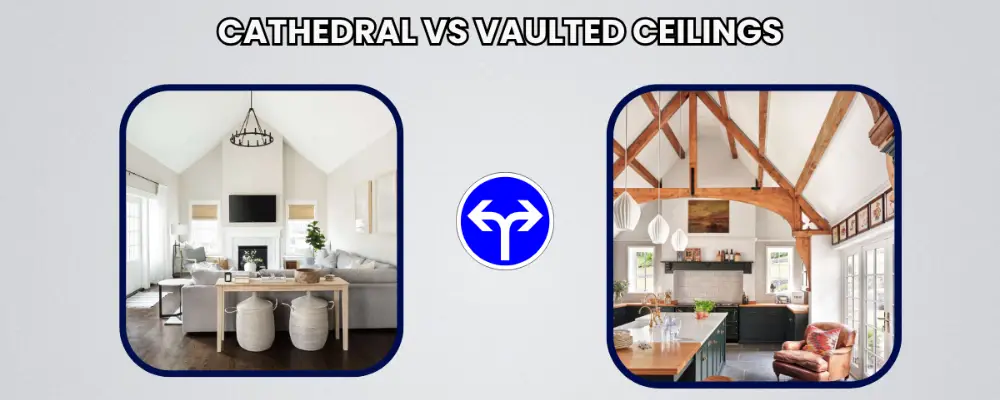The best way to improve the aesthetic and functional appeal is to include ceiling designs. A variety of ceiling designs are used in the construction industry. The topmost ceiling designs are cathedral ceilings and vaulted ceilings. Each type offers a unique touch to the appearance. In terms of grandeur and spaciousness, both designs are appealing for the constructors. However, they vary in design, purpose, and construction method. Various factors play an influential role in selecting the suitable design, such as room size, budget, and desired architectural impact. This article will be a guide and shed light on cathedral and vaulted ceilings, their distinctions, and pros and cons to give readers a better understanding and make a wise decision.
What are Cathedral Ceilings?

It is a symmetrical, sloping ceiling that mirrors the roof’s pitch to create a cohesive and dramatic design. This type of ceiling is commonly seen in churches. You would have realised from where the name cathedral comes into play. The cathedral ceilings often reach impressive heights, providing a sense of openness and luxury. The alignment of uniform slopes and the roof’s angle adds a mesmerising appearance to the structure. Not only in churches, but these designs are even ideal for houses that have steep rooflines. In terms of other aspects, cathedral ceilings increase the natural light penetration, thus providing a feeling of more space.
What are Vaulted Ceilings?

This type of ceiling extends upwards, providing a sense of height and spaciousness. The difference with cathedral ceilings is that vaulted ceilings do not necessarily follow the roof’s pitch. The vaulted ceiling is much more accommodative in terms of design additions. We can add arched, barrel, or domed designs, offering more flexibility in style and shape. This type of ceiling is very famous in Roman architecture to create visually stunning and structurally sound spaces. There is a rise in the usage of vaulted designs both in contemporary and traditional homes because of their aesthetic appeal.
Key Difference between Cathedral Ceiling and Vaulted Ceiling
| Cathedral Ceiling | Vaulted Ceiling |
| The design of the cathedral ceiling mirrors the roof’s pitch with its symmetrical sloping ceiling. | The vaulted ceiling has an upward extension; however, it does not follow roof angles. |
| The uniform slopes of the ceiling meet at a central ridge. | The design structures of vaulted ceilings are arches, domes, or flat sloped designs. |
| In terms of alignment, the slopes always align with the roof’s pitch. | In vaulted ceilings, slopes may or may not align with the roof’s structure. |
| They are well-known for their dramatic and cohesive roofline. | Its flexibility in design adaptation made it possible for various architectural designs. |
| There is a chance of energy loss due to direct roof connection. | It has the potential for better insulation and energy efficiency. |
| It is suitable for houses with steep rooflines | It is suitable for both large and small spaces. |
| In terms of cost, a cathedral ceiling is expensive due to the construction complexity. | Vaulted ceiling costs vary with design and are moderately expensive. |
| Maintaining a cathedral ceiling is difficult due to its height and steep angles. | Compared to cathedral ceilings, vaulted ceilings are much easier to maintain. |
Pros of Cathedral Ceiling
- The inclusion of cathedral ceilings inside structures creates a grand, open look that adds value to the house.
- In smaller houses, the cathedral ceiling can create an illusion of more open and larger space which is beneficial in the projection of smaller rooms.
- It negates the need for additional lighting sources as they have skylights or other types of natural fixtures.
- It is a perfect choice for structures in hot or humid climates because it improves the ventilation of the room.
Cons of Cathedral Ceiling
- The cost of a cathedral ceiling is expensive and the work is more complex than a standard ceiling.
- The maintenance cost of the cathedral ceiling is also high because of its extra height and additional framing and insulation for support.
- The placement of furniture or décor in a room is difficult as the design of the cathedral ceiling is peaked.
- It is very hard to heat and cool a cathedral ceiling due to its height.
Pros of Vaulted Ceiling
- The sense of drama and elegance can be brought in with vaulted ceilings. Similar to a cathedral ceiling, it can make a room feel more open and spacious.
- It has natural lights or fixtures that can help brighten up a room. This reduces the need for artificial lights.
- It can also improve ventilation and is much easier to construct than a cathedral ceiling.
- The key factor in vaulted ceilings is that the roof line is not constrained to the styling of the roof line.
Cons of Vaulted Ceiling
- A vaulted ceiling is more expensive than a standard ceiling but not as expensive as a cathedral ceiling.
- It creates trouble in the winter season because the increase in warm air will increase the utility cost.
- Even a small noise made inside the structure with a vaulted design may amplify manifold.
Choosing the Right Ceiling for Your Space
The dependence of choice between cathedral and vaulted ceiling varies based on several factors such as the room’s size, architectural style, and budget. If there is a wide space, the cathedral ceiling is ideal for steep rooflines with great symmetry and grandeur. Vaulted ceilings are preferred for smaller rooms due to their design versatility. A cathedral ceiling requires more heating and cooling whereas, a vaulted ceiling allows insulation flexibility.
Conclusion
Both cathedral and vaulted ceilings provide beautiful design aesthetics and add a sense of space to your residence. Although vaulted ceilings allow you to be more flexible in your design choices, cathedral ceilings tend to have a stronger visual order. Knowing the parameters for selections, as well as the qualities that the styles possess, would allow you to choose the appropriate ceiling type for your house design, way of living, and financial plan.
FAQs
Yes, they are a perfect choice for small rooms as they are good at creating an illusion of height and openness. However, not all vaulted designs can achieve it. Careful design planning and consideration are required with respect to the room’s dimensions.
Yes, cathedral ceilings are more expensive when compared to all other ceiling designs. It is because of the alignment of the designs with the roof’s slope. This requires precise engineering and construction.
The ability to add insulation pockets makes vaulted ceilings suitable for energy efficiency purposes. Whereas, cathedral ceilings are susceptible to energy loss due to their direct alignment with the roof.

